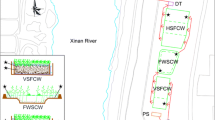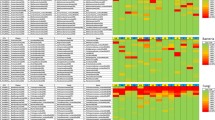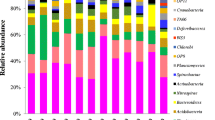Abstract
Constructed wetlands (CWs) constitute an interesting alternative option to conventional systems for wastewater treatment. This technology is based on the utilization of the concerted activity of microorganisms for the removal of contaminants. Consequently, knowledge on the microbial assemblages dwelling CWs and the different environmental factors which can alter their activities is crucial for understanding their performance. In the last decades, the use of molecular techniques to characterize these communities and more recently, application of –omics tools, have broaden our view of microbial diversity and function in wastewater microbiology. In this manuscript, a review of the current knowledge on microbial diversity in CWs is offered, placing particular emphasis on the different molecular studies carried out in this field. The effect of environmental conditions, such as plant species, hydraulic design, water depth, organic carbon, temperature and substrate type on prokaryotic communities has been carefully revised, and the different studies highlight the importance of these factors in carbon, nitrogen and sulfur cycles. Overall, the novel –omics open a new horizon to study the diversity and ecophysiology of microbial assemblages and their interactions in CWs, particularly for those microorganisms belonging to the rare biosphere not detectable with conventional molecular techniques.

Similar content being viewed by others
References
Abed RMM, Al-Kharusi S, Prigent S, Headley T (2014) Diversity, distribution and hydrocarbon biodegradation capabilities of microbial communities in oil-contaminated cyanobacterial mats from a constructed wetland. Plos One 9(12), e114570. doi:10.1371/journal.pone.0114570
Adrados B, Sánchez O, Arias CA, Bécares E, Garrido L, Mas J, Brix H, Morató J (2014) Microbial communities from different types of natural wastewater treatment systems: vertical and horizontal flow constructed wetlands and biofilters. Water Res 55:304–312
Ahn C, Gillevet PM, Sikaroodi M (2007) Molecular characterization of microbial communities in treatment microcosm wetlands as influenced by macrophytes and phosphorus loading. Ecol Indic 7(4):852–863
Ansola G, Arroyo P, Sáenz de Miera LE (2014) Characterisation of the soil bacterial community structure and composition of natural and constructed wetlands. Sci Total Environ 473–474:63–71
Arends JBA, Van Denhouwe S, Verstraete W, Boon N, Rabaey K (2014) Enhanced disinfection of wastewater by combining wetland treatment with bioelectrochemical H2O2 production. Bioresour Technol 155:352–358
Arroyo P, Ansola G, de Miera LES (2013) Effects of substrate, vegetation and flow on arsenic and zinc removal efficiency and microbial diversity in constructed wetlands. Ecol Eng 51:95–103
Bai Y, Liang J, Liu R, Hu C, Qu J (2014) Metagenomic analysis reveals microbial diversity and function in the rhizosphere soil of a constructed wetland. Environ Technol 35(20):2521–2527
Baptista JC, Davenport RJ, Donnelly T, Curtis TP (2008) The microbial diversity of laboratory-scale wetlands appears to be randomly assembled. Water Res 42:3182–3190
Bock E, Schmidt I, Stüven R, Zart D (1995) Nitrogen loss caused by denitrifying Nitrosomonas cells using ammonium or hydrogen as electron donors and nitrite as electron acceptor. Arch Microbiol 163(1):16–20
Brune A, Frenzel P, Cypionka H (2000) Life at the oxic-anoxic interface: microbial activities and adaptations. FEMS Microbiol Rev 24(5):691–710
Calheiros CSC, Duque AF, Moura A, Henriques IS, Correia A, Rangel AOSS, Castro PML (2009) Changes in the bacterial community structure in two-stage constructed wetlands with different plants for industrial wastewater treatment. Bioresour Technol 100(13):3228–3235
Calheiros CSC, Duque AF, Moura A, Henriques IS, Correia A, Rangel AOSS, Castro PML (2009) Substrate effect on bacterial communities from constructed wetlands planted with Typha latifolia treating industrial wastewater. Ecol Eng 35(5):744–753
Chang J-J, Wu S-Q, Liang K, Wu Z, Liang W (2015) Comparative study of microbial community structure in integrated vertical-flow constructed wetlands for treatment of domestic and nitrified wastewaters. Environ Sci Pollut Res 22(5):3518–3527
Cooper PF, Job GD, Green MB, Shutes RBE (1996) Reed beds and constructed wetlands for wastewater treatment. WRc publications, Medmenham
Cypionka H (2000) Oxygen respiration by Desulfovibrio species. Annu Rev Microbiol 54:827–848
DeJournett TD, Arnold WA, LaPara TM (2007) The characterization and quantification of methanotrophic bacterial populations in constructed wetland sediments using PCR targeting 16S rRNA gene fragments. Appl Soil Ecol 35(3):648–659
Desta AF, Assefa F, Leta S, Stomeo F, Wamalwa M, Njahira M, Appolinaire D (2014) Microbial community structure and diversity in an integrated system of anaerobic-aerobic reactors and a constructed wetland for the treatment of tannery wastewater in Modjo, Ethiopia. Plos One 9(12), e115576. doi:10.1371/journal.pone.0115576
Doherty L, Zhao Y, Zhao X, Hu Y, Hao X, Xu L, Liu R (2015) A review of a recently emerged technology: constructed wetland—microbial fuel cells. Water Res 85:38–45
Dong X, Reddy GB (2010) Soil bacterial communities in constructed wetlands treated with swine wastewater using PCR-DGGE technique. Bioresour Technol 101(4):1175–1182
Elsayed OF, Maillard E, Vuilleumier S, Imfeld G (2014) Bacterial communities in batch and continuous-flow wetlands treating the herbicide S-metolachlor. Sci Total Environ 499(1):327–335
Fan J, Zhang J, Guo W, Liang S, Wu H (2016) Enhanced long-term organics and nitrogen removal and associated microbial community in intermittently aerated subsurface flow constructed wetlands. Bioresour Technol 214:871–875
Faulwetter JL, Burr MD, Parker AE, Stein OR, Camper AK (2013) Influence of season and plant species on the abundance and diversity of sulfate reducing bacteria and ammonia oxidizing bacteria in constructed wetland microcosms. Microb Ecol 65(1):111–127
Faulwetter JL, Gagnon V, Sundberg C, Chazarenc F, Burr MD, Brisson J, Camper AK, Stein OR (2009) Microbial processes influencing performance of treatment wetlands: a review. Ecol Eng 35(6):987–1004
Ferrera I, Sánchez O (2016) Insights into microbial diversity in wastewater treatment systems: how far have we come? Biotechnol Adv 34(5):790–802
Gagnon V, Chazarenc F, Comeau Y, Brisson J (2007) Influence of macrophyte species on microbial density and activity in constructed wetlands. Water Sci Technol 56(3):249–254
Gorra R, Coci M, Ambrosoli R, Laanbroek HJ (2007) Effects of substratum on the diversity and stability of ammonia-oxidizing communities in a constructed wetland used for wastewater treatment. J Appl Microbiol 103(5):1442–1452
Guan W, Yin M, He T, Xie S (2015) Influence of substrate type on microbial community structure in vertical-flow constructed wetland treating polluted river water. Environ Sci Pollut Res 22:16202–16209
He T, Guan W, Luan Z, Xie S (2016) Spatiotemporal variation of bacterial and archaeal communities in a pilot-scale constructed wetland for surface water treatment. Appl Microbiol Biotechnol 100:1479–1488
Holmer M, Storkholm P (2001) Sulfate reduction and sulphur cycling in lake sediments: a review. Freshw Biol 46(4):431–451
Iasur-Kruh L, Hadar Y, Milstein D, Gasith A, Minz D (2010) Microbial population and activity in wetland microcosms constructed for improving treated municipal wastewater. Microb Ecol 59(4):700–709
Ibekwe AM, Grieve CM, Lyon SR (2003) Characterization of microbial communities and composition in constructed dairy wetland wastewater effluent. Appl Environ Microbiol 69(9):5060–5069
Ibekwe AM, Ma J, Murinda S, Reddy GB (2016) Bacterial community dynamics in surface flow constructed wetlands for the treatment of swine waste. Sci Total Environ 544:68–76
Kadlec RH (2008) The effects of wetland vegetation and morphology on nitrogen processing. Ecol Eng 33(2):126–141
Kadlec RH (2009) Comparison of free water and horizontal subsurface treatment wetlands. Ecol Eng 35(2):159–174
Kadlec RH, Wallace S (2009) Treatment wetlands. CRC press, Boca Raton
King JK, Harmon SM, Fu TT, Gladden JB (2002) Mercury removal, methylmercury formation, and sulfate-reducing bacteria in wetland mesocosms. Chemosphere 46(6):859–870
Kosolapov DB, Kuschk P, Vainshtein MB, Vatsourina AV, Wießner A, Kästner M, Müller RA (2004) Microbial processes of heavy metal removal from carbon-deficient effluents in constructed wetlands. Eng Life Sci 4(5):403–411
Li M, Zhou Q, Tao M, Wang Y, Jiang L, Wu Z (2010) Comparative study of microbial community structure in different filter media of constructed wetland. J Environ Sci 22(1):127–133
Li X, Zhang M, Liu F, Li Y, He Y, Zhang S, Wu J (2015) Abundance and distribution of microorganisms involved in denitrification in sediments of a Myriophyllum elatinoides purification system for treating swine wastewater. Environ Sci Pollut Res 22(22):17906–17916
Li Y, Wu B, Zhu G, Liu Y, Ng WJ, Appan A, Tan SK (2016) High-throughput pyrosequencing analysis of bacteria relevant to cometabolic and metabolic degradation of ibuprofen in horizontal subsurface flow constructed wetlands. Sci Total Environ 562:604–613
Ligi T, Oopkaup K, Truu M, Preem J-K, Nolvak H, Mitsch WJ, Mander Ü, Truu J (2014) Characterization of bacterial communities in soil and sediment of a created riverine wetland complex using high-throughput 16S rRNA amplicon sequencing. Ecol Eng 72:56–66
Lin Y-F, Jing S-R, Lee D-Y, Chang Y-F, Shih K-C (2008) Nitrate removal from groundwater using constructed wetlands under various hydraulic loading rates. Bioresour Technol 99(16):7504–7513
Lloyd JR, Klessa DA, Parry DL, Buck P, Brown NL (2004) Stimulation of microbial sulphate reduction in a constructed wetland: microbiological and geochemical analysis. Water Res 38(7):1822–1830
Lünsmann V, Kappelmeyer U, Benndorf R, Martinez-Lavanchy PM, Taubert A, Adrian L, Duarte M, Pieper DH, von Bergen M, Müller JA, Heipieper HJ, Jehmlich N (2016) In situ protein-SIP highlights Burkholderiaceae as key players degrading toluene by para ring hydroxylation in a constructed wetland model. Environ Microbiol 18(4):1176–1186
Lünsmann V, Kappelmeyer U, Taubert A, Nijenhuis I, von Bergen M, Heipieper HJ, Müller JA, Jehmlich N (2016) Aerobic toluene degraders in the rhizosphere of a constructed wetland model show diurnal polyhydroxyalkanoate metabolism. Appl Environ Microbiol 82(14):4126–4132
Lv T, Zhang Y, Carvalho PN, Zhang L, Button M, Arias CA, Weber KP, Brix H (2016) Microbial community metabolic function in constructed wetland mesocosms treating the pesticides imazalil and tebuconazole. Ecol Eng. doi:10.1016/j.ecoleng.2016.07.004
Martínez-Lavanchy PM, Chen Z, Lünsmann V, Marin-Cevada V, Vilchez-Vargas R, Pieper DH, Reiche N, Kappelmeyer U, Imparato V, Junca H, Nijenhuis I, Müller JA, Kuschk P, Heipieper HJ (2015) Microbial toluene removal in hypoxic model constructed wetlands occurs predominantly via the ring monooxygenation pathway. Appl Environ Microbiol 81(18):6241–6252
Morató J, Codony F, Sánchez O, Martín Pérez L, García J, Mas J (2014) Key design factors affecting microbial community composition and pathogenic organism removal in horizontal subsurface flow constructed wetlands. Sci Total Environ 481:81–89
Nielsen PH, Mielczarek AT, Kragelund C, Nielse JL, Saunders AM, Kong Y, Hansen AA, Vollertsen J (2012) A conceptual model system of microbial communities in enhanced biological phosphorus removal plants. Water Res 44:5070–5088
Nikolausz M, Kappelmeyer U, Széleky A, Rusznyák KM, Kästner M (2008) Diurnal redox fluctuation and microbial activity in the rhizosphere of wetland plants. Eur J Soil Biol 44(3):324–333
Paranychianakis NV, Tsiknia M, Kalogerakis N (2016) Pathways regulating the removal of nitrogen in planted and unplanted subsurface flow constructed wetlands. Water Res 102:321–329
Pedrós-Alió C (2007) Ecology. Dipping into the rare biosphere. Science 315(5809):192–193
Pedrós-Alió C (2012) The rare bacterial biosphere. Annu Rev Mar Sci 4:449–466
Ramond J-B, Welz PJ, Tuffin MI, Burton SG, Cowan DA (2013) Assessment of temporal and spatial evolution of bacterial communities in a biological sand filter mesocosm treating winery wastewater. J Appl Microbiol 115(1):91–101
Ravit B, Ehenfeld JG, Häggblom MM (2006) Effects of vegetation on root-associated microbial communities: a comparison of disturbed versus undisturbed estuarine sediments. Soil Biol Biochem 38:2359–2371
Russell RA, Holden PJ, Wilde KL, Neilan BA (2003) Demonstration of the use of Scenedesmus and Carteria biomass to drive bacterial sulfate reduction by Desulfovibrio alcoholovorans isolated from an artificial wetland. Hydrometallurgy 71(1–2):227–234
Schmidt I, Sliekers O, Schmid M, Bock E, Fuerst J, Gijs Kuenen J, Jetten MSM, Strous M (2003) New concepts of microbial treatment processes for the nitrogen removal in wastewater. FEMS Microbiol Rev 27(4):481–492
Sidrach-Cardona R, Sánchez O, Garrido L, Mas J, Bécares E (2015) Molecular characterization of microbial communities in constructed wetlands: the effect of plant species, organic matter and hydraulic design. In: Barret LM (ed) Wastewater treatment. Nova Science Publishers, Inc, New York, pp 45–67
Sigalevich P, Baev MV, Teske A, Cohen Y (2000) Sulfate reduction and possible aerobic metabolism of the sulfate-reducing bacterium Desulfovibrio oxyclinae in a chemostat coculture with Marinobacter sp. strain MB under exposure to increasing oxygen concentrations. Appl Environ Microbiol 66(11):5013–5018
Sleytr K, Tietz A, Langergraber G, Haberl R, Sessitsch A (2009) Diversity of abundant bacteria in subsurface vertical flow constructed wetlands. Ecol Eng 35(6):1021–1025
Song ZW, Wang L, Xu AL, Wu DD, Xia Y (2015) Carbon sources metabolic characteristics of airborne microbial communities in constructed wetlands. Huang Jing Ke Xue 36(2):415–420
Stottmeister U, Wiessner A, Kuschk P, Kappelmeyer MK, Bederski RA, Müller H, Moormann H (2003) Effects of plants and microorganisms in constructed wetlands for wastewater treatment. Biotechnol Adv 22(1–2):93–117
Sundberg C, Stendahl JSK, Tonderski K, Lindgren P-E (2007) Overland flow systems for treatment of landfill leachates—potential nitrification and structure of the ammonia-oxidising bacterial community during a growing season. Soil Biol Biochem 39(1):127–138
Tietz A, Hornek R, Langergraber G, Kreuzinger N, Haberl R (2007) Diversity of ammonia oxidizing bacteria in a vertical flow constructed wetland. Water Sci Technol 56(3):242–247
Truu M, Juhanson J, Truu J (2009) Microbial biomass, activity and community composition in constructed wetlands. Sci Total Environ 407(13):3958–3971
Vacca G, Wand H, Nikolausz M, Kuschk P, Kästner M (2005) Effect of plants and filter material on bacterial removal in pilot-scale constructed wetlands. Water Res 39(7):1361–1373
Vymazal J (2005) Removal of enteric bacteria in constructed treatment wetlands with emergent macrophytes: a review. J Environ Sci Health 40(6–7):1355–1367
Vymazal J (2011) Constructed wetlands for wastewater treatment: five decades of experience. Environ Sci Technol 45(1):61–69
Vymazal J (2013) Emergent plants in free water surface constructed wetlands: a review. Ecol Eng 61P:582–592
Vymazal J, Brezinova T (2015) The use of constructed wetlands for removal of pesticides from agricultural runoff and drainage: a review. Environ Int 75C:11–20
Wang Q, Xie H, Ngo HH, Guo W, Zhang J, Liu C, Liang S, Hu Z, Yang Z, Zhao C (2016) Microbial abundance and community in subsurface flow constructed wetland microcosms: role of plant presence. Environ Sci Pollut Res 23:4036–4045
Wu S, Kuschk P, Brix H, Vymazal J, Dong R (2014) Development of constructed wetlands in performance intensifications for wastewater treatment: a nitrogen and organic matter targeted review. Water Res 57C:40–55
Wu Y, Han R, Yang X, Fang X, Chen X, Yang D, Zhang R (2016) Correlating microbial community with physicochemical indices and structures of a full-scale integrated constructed wetland system. Appl Microbiol Biotechnol 100(15):6917–6926
Xu M, Liu W, Li C, Xiao C, Ding L, Xu K, Geng J, Ren H (2016) Evaluation of the treatment performance and microbial communities of a combined constructed wetland used to treat industrial park wastewater. Environ Sci Pollut Res 23(11):10990–11001
Yi X-H, Jing D-D, Wan J, Ma Y, Wang Y (2016) Temporal and spatial variations of contaminant removal, enzyme activities, and microbial community structure in a pilot horizontal subsurface flow constructed wetland purifying industrial runoff. Environ Sci Pollut Res 23(9):8565–8576
Yin J, Jiang L, Wen Y, Yao Z, Zhou Q (2009) Treatment of polluted landscape lake water and community analysis of ammonia-oxidizing bacteria in constructed wetland. J Environ Sci Health A Tox Hazard Subst Environ Eng 44(7):722–731
Zhai X, Piwpuan N, Arias CA, Headley T, Brix H (2013) Can root exudates from emergent wetland plants fuel denitrification in subsurface flow constructed wetland systems? Ecol Eng 61P:555–563
Zhao C, Xie H, Xu J, Xu X, Zhang J, Hu Z, Liu C, Liang S, Wang Q, Wang J (2015) Bacterial community variation and microbial mechanism of triclosan (TCS) removal by constructed wetlands with different types of plants. Sci Total Environ 505:633–639
Zhong F, Wu J, Dai Y, Yang L, Zhang Z, Cheng S, Zhang Q (2015) Bacterial community analysis by PCR-DGGE and 454-pyrosequencing of horizontal subsurface flow constructed wetlands with front aeration. Appl Microbiol Biotechnol 99(3):1499–1512
Acknowledgments
The author thanks Dr. Isabel Ferrera for her help. This work was supported by the Spanish grant CTM2015-70340-R from the Ministerio de Economía y Competitividad.
Author information
Authors and Affiliations
Corresponding author
Rights and permissions
About this article
Cite this article
Sánchez, O. Constructed Wetlands Revisited: Microbial Diversity in the –omics Era. Microb Ecol 73, 722–733 (2017). https://doi.org/10.1007/s00248-016-0881-y
Received:
Accepted:
Published:
Issue Date:
DOI: https://doi.org/10.1007/s00248-016-0881-y




